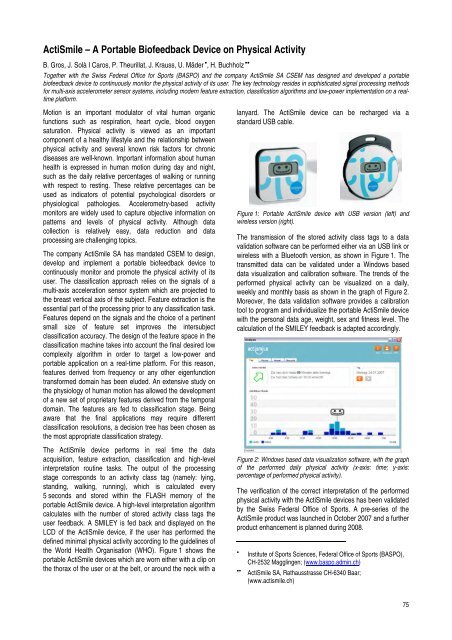research activities in 2007 - CSEM
research activities in 2007 - CSEM
research activities in 2007 - CSEM
You also want an ePaper? Increase the reach of your titles
YUMPU automatically turns print PDFs into web optimized ePapers that Google loves.
ActiSmile – A Portable Biofeedback Device on Physical Activity<br />
B. Gros, J. Solà I Caros, P. Theurillat, J. Krauss, U. Mäder • , H. Buchholz ••<br />
Together with the Swiss Federal Office for Sports (BASPO) and the company ActiSmile SA <strong>CSEM</strong> has designed and developed a portable<br />
biofeedback device to cont<strong>in</strong>uously monitor the physical activity of its user. The key technology resides <strong>in</strong> sophisticated signal process<strong>in</strong>g methods<br />
for multi-axis accelerometer sensor systems, <strong>in</strong>clud<strong>in</strong>g modern feature extraction, classification algorithms and low-power implementation on a realtime<br />
platform.<br />
Motion is an important modulator of vital human organic<br />
functions such as respiration, heart cycle, blood oxygen<br />
saturation. Physical activity is viewed as an important<br />
component of a healthy lifestyle and the relationship between<br />
physical activity and several known risk factors for chronic<br />
diseases are well-known. Important <strong>in</strong>formation about human<br />
health is expressed <strong>in</strong> human motion dur<strong>in</strong>g day and night,<br />
such as the daily relative percentages of walk<strong>in</strong>g or runn<strong>in</strong>g<br />
with respect to rest<strong>in</strong>g. These relative percentages can be<br />
used as <strong>in</strong>dicators of potential psychological disorders or<br />
physiological pathologies. Accelerometry-based activity<br />
monitors are widely used to capture objective <strong>in</strong>formation on<br />
patterns and levels of physical activity. Although data<br />
collection is relatively easy, data reduction and data<br />
process<strong>in</strong>g are challeng<strong>in</strong>g topics.<br />
The company ActiSmile SA has mandated <strong>CSEM</strong> to design,<br />
develop and implement a portable biofeedback device to<br />
cont<strong>in</strong>uously monitor and promote the physical activity of its<br />
user. The classification approach relies on the signals of a<br />
multi-axis acceleration sensor system which are projected to<br />
the breast vertical axis of the subject. Feature extraction is the<br />
essential part of the process<strong>in</strong>g prior to any classification task.<br />
Features depend on the signals and the choice of a pert<strong>in</strong>ent<br />
small size of feature set improves the <strong>in</strong>tersubject<br />
classification accuracy. The design of the feature space <strong>in</strong> the<br />
classification mach<strong>in</strong>e takes <strong>in</strong>to account the f<strong>in</strong>al desired low<br />
complexity algorithm <strong>in</strong> order to target a low-power and<br />
portable application on a real-time platform. For this reason,<br />
features derived from frequency or any other eigenfunction<br />
transformed doma<strong>in</strong> has been eluded. An extensive study on<br />
the physiology of human motion has allowed the development<br />
of a new set of proprietary features derived from the temporal<br />
doma<strong>in</strong>. The features are fed to classification stage. Be<strong>in</strong>g<br />
aware that the f<strong>in</strong>al applications may require different<br />
classification resolutions, a decision tree has been chosen as<br />
the most appropriate classification strategy.<br />
The ActiSmile device performs <strong>in</strong> real time the data<br />
acquisition, feature extraction, classification and high-level<br />
<strong>in</strong>terpretation rout<strong>in</strong>e tasks. The output of the process<strong>in</strong>g<br />
stage corresponds to an activity class tag (namely: ly<strong>in</strong>g,<br />
stand<strong>in</strong>g, walk<strong>in</strong>g, runn<strong>in</strong>g), which is calculated every<br />
5 seconds and stored with<strong>in</strong> the FLASH memory of the<br />
portable ActiSmile device. A high-level <strong>in</strong>terpretation algorithm<br />
calculates with the number of stored activity class tags the<br />
user feedback. A SMILEY is fed back and displayed on the<br />
LCD of the ActiSmile device, if the user has performed the<br />
def<strong>in</strong>ed m<strong>in</strong>imal physical activity accord<strong>in</strong>g to the guidel<strong>in</strong>es of<br />
the World Health Organisation (WHO). Figure 1 shows the<br />
portable ActiSmile devices which are worn either with a clip on<br />
the thorax of the user or at the belt, or around the neck with a<br />
lanyard. The ActiSmile device can be recharged via a<br />
standard USB cable.<br />
Figure 1: Portable ActiSmile device with USB version (left) and<br />
wireless version (right).<br />
The transmission of the stored activity class tags to a data<br />
validation software can be performed either via an USB l<strong>in</strong>k or<br />
wireless with a Bluetooth version, as shown <strong>in</strong> Figure 1. The<br />
transmitted data can be validated under a W<strong>in</strong>dows based<br />
data visualization and calibration software. The trends of the<br />
performed physical activity can be visualized on a daily,<br />
weekly and monthly basis as shown <strong>in</strong> the graph of Figure 2.<br />
Moreover, the data validation software provides a calibration<br />
tool to program and <strong>in</strong>dividualize the portable ActiSmile device<br />
with the personal data age, weight, sex and fitness level. The<br />
calculation of the SMILEY feedback is adapted accord<strong>in</strong>gly.<br />
Figure 2: W<strong>in</strong>dows based data visualization software, with the graph<br />
of the performed daily physical activity (x-axis: time; y-axis:<br />
percentage of performed physical activity).<br />
The verification of the correct <strong>in</strong>terpretation of the performed<br />
physical activity with the ActiSmile devices has been validated<br />
by the Swiss Federal Office of Sports. A pre-series of the<br />
ActiSmile product was launched <strong>in</strong> October <strong>2007</strong> and a further<br />
product enhancement is planned dur<strong>in</strong>g 2008.<br />
•<br />
Institute of Sports Sciences, Federal Office of Sports (BASPO),<br />
CH-2532 Maggl<strong>in</strong>gen; (www.baspo.adm<strong>in</strong>.ch)<br />
••<br />
ActiSmile SA, Rathausstrasse CH-6340 Baar;<br />
(www.actismile.ch)<br />
75








